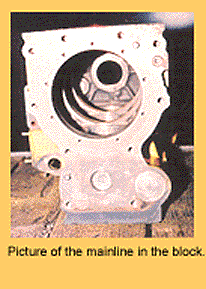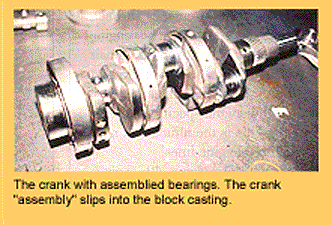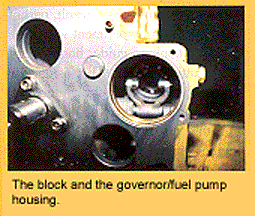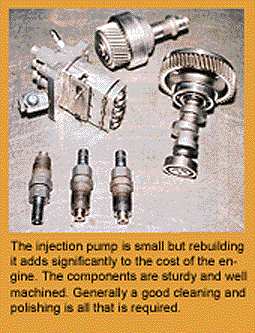Looking for new markets is one of the toughest things we do, so every time the phone rings we listen for an opportunity. Most of what we find is suspect, but over the past 12 months we have rebuilt a number of compact diesels and sold a number of rebuild kits. As a result we began to discuss the market more seriously.
I sometimes wonder if we will ever outgrow our prejudices; the prevailing opinion in our shop seems to be that compact diesels have only two things wrong with them: the bores are smaller than 4? and they are not painted CAT yellow or John Deere green. However wrong-headed a comment like that may seem, it does indirectly raise the right question: can we make as much money rebuilding small diesels as we do in our base business?
Whether a shop will make any money from developing a new engine market is tough to figure. Ultimately, you’ll have to get started before you know for sure, and that is what we have basically done. However, along the way we asked ourselves a few critical questions to help us sort out the risks and the challenges.
Questions such as: How big is the market? What is the investment to get started? Can we do the shop work efficiently? Can we buy the parts competitively? Can we sell for a profit?
The Market
For us, getting a handle on the compact diesel market turned out to have both an easy part and a hard part. The easy part was picking Kubota as the most common engine over Ford, Mitsubishi, Yanmar and some other compact diesel manufacturers. Once we looked at our own limited experience and talked to the equipment dealers, the answer became fairly clear.
In our area in rural Oregon, there are large numbers of smaller farms, vineyards and specialty farms. They not only use smaller tractors and other agricultural equipment, but they use pumps, generators and specialty equipment. Their brand of choice seems to be the Kubota.
The hard part was trying to find out which Kubota engines were the ones we should focus on. And as we began to catalog the many engine variations in the market, we began to see some of the things that make this engine a tough and potentially less profitable business opportunity.
In talking to the Industrial Kubota distributor and the Agricultural (Ag) Kubota dealers we found that they could not provide much information on the engine types that were available in the market. However, with some work, we were able to piece together a general picture.
What we learned was that Kubota runs two distinctly different supply chains: one for industrial engines and one for agricultural engines. In fact, everything is separate. The engine designations do not match; the repair parts cataloging is separate; the part numbering is different; and even some of the engine specifications are different. This is the ultimate in non-standardized engine lines!
We catalogued some 40 engines between 30 cid and 100 cid. Some engines appeared to be the same but the bore or stroke was different. With some engines the bore and stroke were the same but the horsepower was very different and the engines specified different pistons. Some engines were identical internally but had very different accessory arrangements. We finally decided we were sufficiently confused and that we could now move forward with the program!
The Engine Work
We initiated some marketing to bring in some of these jobs, and after building half a dozen small Kubota diesels we began taking stock of our experience. The engines are fun to work on and are amazingly small and compact. They are easy to disassemble, clean and handle, so there are some small efficiencies there. In many cases, the whole engine project can fit on to a modest sized shop cart.
Machining did require some smaller tooling than what we had available (however, a general automotive machine shop may already have the necessary tooling). As a result, part of the price of our experiment was some cylinder honing, guide honing and valve cutting tooling. That aside, the machine work is fairly straightforward.
The quality of the Kubota castings and the machining of the smaller engine components are good. The initial quality is definitely built into these engines. The components are sturdy and lend themselves to rebuilding. You feel like you are working on a heavy duty sewing machine.

Of the engines we have remanufactured, none has had a bad crank and only two required the crank to be ground. The cams are generally sound and the governor components and rocker assemblies are good. I wish the same could be said for the cylinder heads. The heads are, and will continue to be, a challenge.
The cylinder head castings we have seen tend to crack between intake and exhaust seats or between one of the seats and the pre-chambers. We have seen this as well on all models including Yanmar, Kubota and Ford. We are developing both pinning and welding techniques to save these heads because the economics of the engine rebuild demand it. However, these heads are very small and in some cases there is not enough width or thickness to work with. It is here we begin to see th
The price of OEM replacement head castings is prohibitive and you can easily lose a job after disassembling, cleaning and checking out the engine components. Every Kubota or other small diesel engine rebuild job we lost was because the cylinder head was not repairable, and the cost of a replacement head forced the customer to withdraw. In fact, if you have any component part that needs to be replaced the impact on costs can affect whether you get to do the job.

If the machine work portion of the rebuild is straightforward, assembly of the engine requires some special skills and experience. There are several "interesting" design features of the Kubota mainline and fuel injection pump. However, after rebuilding two or three engines we were comfortable with the differences.
The mainline is actually a housing bore into which the crank assembly fits. Clearances and wear are critical.
The Kubota block does not have traditional mainline or main caps. The engine uses a set of "mainline supports" that bolt to the crank, holding the bearings. The assembly of the crank, bearings and the supports is then inserted into the block mainline. The mainline in the block is a large diameter hole that must be checked carefully. While unusual, it is relatively easy to master the tricks to assemble this system. A shop manual for Kubota engines is a must.
The block casting has an integrated injection pump/governor housing, cast into the block. There are a number of different configurations of this injection pump/governor housing. We have seen a number of these and each is somewhat unique. The injection pump timing and the governor settings must be c
The injection pump runs off the small camshaft in the pump/governor housing. The pump timing is controlled by the relationship of the pump cam (in the block) to the pump’s roller lifters. Kubota uses shims between the pump and the pump mounting surface to adjust the fuel timing of the engine.
In the case of the D905 (often used in generator sets) we are currently building, the pump mounting surface is at an angle to the block deck surface, and we can surface the block without touching the pump mounting surface. In other engines we have seen, the block deck and the pump deck are the same. When you surface the block you surface the pump mounting surface, too. In these cases you must re-time (shim) the pump. Again, the shop manual is an essential part of the engine assembler’s tool kit.
Kubota engines have several different governor arrangements and knowing how to adjust each is important. Most applications are governed and each is unique.

Overall, given what we have discussed so far, you might anticipate that a shop’s manpower efficiencies for these engines would be comparable to other small engines. You could assume that, however, you would be wrong! For an explanation of why, let’s discuss specifications and parts.
Can I Buy Parts Competitively?
Absolutely! But remember, being competitive (buying at the same price as other shops) and buying parts at a reasonable cost (which makes the rebuild affordable) are two different things. Plan to pay the same high price that everyone else does for OEM parts. So far, we have not found a source of aftermarket parts.
In the past we have found ourselves at a slight disadvantage compared to some Kubota dealers who do rebuilding. It is tough to buy parts from your competitor. However, on a positive note, we continue to do short and long block rebuilds for these dealers and we even managed to negotiate a 10 percent margin on the parts as part of the deal.

In addition to parts pricing, parts cataloging is a major issue when it comes to rebuilding these engines. For Kubota particularly, the cataloging is difficult and time consuming to understand. If you look at the time your parts person will spend getting the right parts for Kubota rebuilds, it may have you thinking twice about doing many of these rebuilds. Your parts person will have to be as efficient as your shop personnel. The problems with Kubota are twofold: Kubota has two separate parts supply systems, mean the parts do not cross reference, and the cataloging in both supply systems is weak.
First, for the industrial engines you will go to the Industrial Kubota distributor. For us, this is a fairly large company and they are relatively efficient. However, for the agricultural engines we are forced to buy parts from one of several local Ag dealers. And neither of these two suppliers are really equipped to provide rapid service for their parts businesses either.
Looking at our experience, the number of different engines and the complexity of Kubota’s cataloging has somewhat hindered our rebuilding efficiency. During one rebuild of a D905E, we ordered, had delivered, and tried to install four different sets of main bearings. The cataloging was just wrong! Only when we had the parts supplier physically match the bearings did we succeed. Meanwhile the assembler’s time is not well utilized, neither is that of the parts person, therefore efficiency goes right out the window.
The front cover and gear trains vary considerably. The front covers have intricate shapes and getting the right gaskets is difficult and very important. In many models the water and oil are present behind the covers and separated only by the gasket material.
While parts pricing may be the same for most rebuilders, the high prices of these parts do create a marketing problem; parts pricing drives up the cost of a complete engine rebuild. Consequently, customers seek and find other alternatives, or they cut corners on the rebuild.
It is not unusual to pay $800- $1,200 replacing all the basic engine parts during a rebuild. For most shops, when you add the parts markup, injection pump recondition, injector replacement, labor and machine work the total ticket can exceed $3,000. If you have to replace a core part, like a cracked head, then the engine rebuild really moves into heady pricing territory.
You may choose to cut down the costs by doing partial rebuilds. These engines are amazingly sturdy and you may choose not to replace some parts. You may choose to develop "re-use guidelines" that work for your shop. The price of that opportunity may be the shop owners’ willingness to offer a warranty that protects the customer. To date, our shop has chosen to replace all parts unless the customer has accepted the alternative approach in writing. We stand behind what we do, but we cannot guarantee what we do NOT do.
Selling At A Profit
Having come to the topics of the customer and the market, let’s look at some of the good news. Customers, particularly individual customers, seem willing to pay substantial prices to rebuild these small diesel engines. Our job as rebuilders is to understand that, cultivate it and capture the business.
For us, shop efficiency is critical and we struggle daily to understand how we are doing on each job. The temptation with these engines is to overlook their real costs and fall in love with selling a relatively high priced small engine.
In many ways it takes just as much time to rebuild a small diesel as its heavier counterpart. However, some shops that know their costs will not take on these smaller diesels if they mean lower profits.
Having visited the dark side we need to realize that the picture for small diesel rebuilding is not all doom and gloom. There are a couple of other factors that make these smaller diesels worth a second look in your shop. In the past, the Kubota dealer has had an advantage. When a customer’s engine failed and rebuilding was too expensive, the dealer could offer a reasonably priced new replacement engine. Like many engine manufacturers today, they would rather sell new engines and keep the customer out of the rebuilding market if they can. But that may be coming to an end.
This year Tier II EPA regulations are being enforced on most compact diesel models. This means the only new engines that can be sold are engines that meet the more stringent Tier II emissions criteria. As a result, new engines for older engine models may no longer be sold. However, the sale of replacement long and short blocks is an open issue. But the dealer may be forced to sell only new, low emission engines, which may not fit into the older applications. Result: we may have a rebuilding market here! Certainly the customer has one less option to choose from. In some cases the customer may be faced with either rebuilding the engine or buying new equipment.
Final Thoughts
Our shop will continue to move slowly into the small diesel rebuild market. We will do so keeping a close eye on the efficiencies of our assemblers, the amount of machine work needed for these engines and the parts content.
The cost of parts is not likely to change dramatically in the near future. We may see some aftermarket activity in time, but for now we will have to rely on developing relationships with our distributor and dealer contacts.
In short, the jury is still out. My gut feeling is that these smaller engines will never be as profitable as some other jobs, but only some added experience will tell us for sure. Guess we are back to the old "do it and we will see" approach to new market development for our businesses.
Mike Jeffries is current president and owner of Lane Parts Co. in Eugene, OR. Lane Parts has been rebuilding industrial and agricultural diesel engines for over 50 years and Mike has been involved in the company since 1995. He also serves on the Engine Rebuilders Association (AERA) Board of Directors and is Chairman of the Government Affairs Committee.













